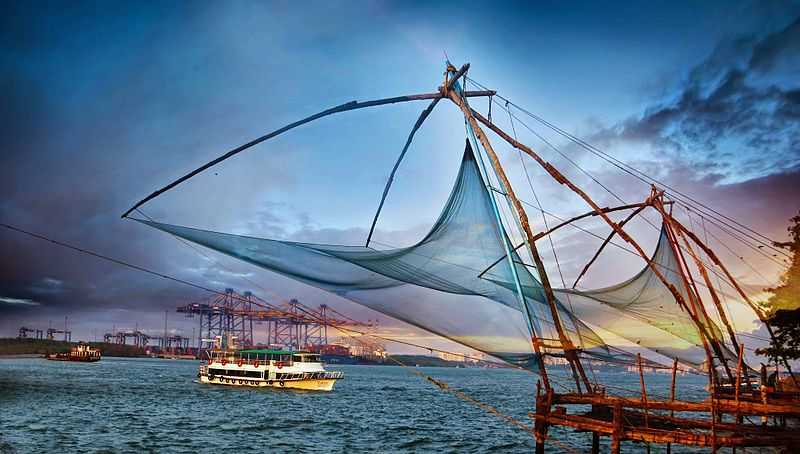
TravelINDIA.COM
Kochi
Kochi is Not a City,
It's a Feeling
Home Page
Kochi, also known as Cochin , is a major port city on the south-west coast of India bordering the Laccadive Sea. It is
part of the district of Ernakulam in the state of Kerala and is often referred to as Ernakulam. The city has a
corporation limit population of 612,343,and a metropolitan population of 2.1 million, making it the largest urban
agglomeration in Kerala. Kochi city is also part of the Greater Cochin region and is classified as a Tier-II city
by the Government of India. The civic body that governs the city is the Kochi Municipal Corporation, which was
constituted in the year 1967, and the statutory bodies that oversee its development are the Greater Cochin Development
Authority (GCDA) and the Goshree Islands Development Authority (GIDA).
Called the Queen of the Arabian Sea, Kochi was an important spice trading centre on the west coast of India from the 14th
century onward, and maintained a trade network with Arab merchants from the pre-Islamic era. Occupied by the Portuguese
in 1503, Kochi was the first of the European colonies in colonial India. It remained the main seat of Portuguese India
until 1530, when Goa was chosen instead. The city was later occupied by the Dutch and the British, with the Kingdom of
Cochin becoming a princely state. Kochi ranks first in the total number of international and domestic tourist arrivals
in Kerala.Kochi has been ranked the sixth best tourist destination in India according to a survey conducted by the
Nielsen Company on behalf of the Outlook Traveller magazine.Kochi was one of the 28 Indian cities among the emerging
440 global cities that will contribute 50% of the world GDP by the year 2025, in a 2011 study done by the McKinsey
Global Institute.
Kochi is known as the financial,commercial and industrial capital of Kerala. It is the home to Southern Naval Command of
the Indian Navy and the state headquarters of the Indian Coast Guard with an attached air squadron, named Air
Squadron 747. Commercial maritime facilities of the city include the Port of Kochi, an International Container
Transshipment Terminal, the Cochin Shipyard, offshore SPM of the BPCL Kochi Refinery and the Kochi Marina. Kochi is also
home for the Cochin Stock Exchange, International Pepper Exchange, companies like HMT, Cyber City, Kinfra Hi-Tech Park,
chemical companies like the FACT, TCC, IREL, Petronet LNG, Merchem, HOCL and Kochi Refineries, electrical companies like
TELK, and industrial parks like the Cochin Special Economic Zone, Smart City and Infopark. Kochi is home for the High
Court of Kerala and Lakshadweep, Naval physical and oceanographic laboratory (NPOL), Indian Maritime University, Sree
sankara Sanskrit University and the Cochin University of Science and Technology. Kochi is also home to Kerala's National
Law School, The National University of Advanced Legal Studies. Kochi has been hosting India's first art biennale, the
Kochi-Muziris Biennale, since 2012, which attracts international artists and tourists.
History
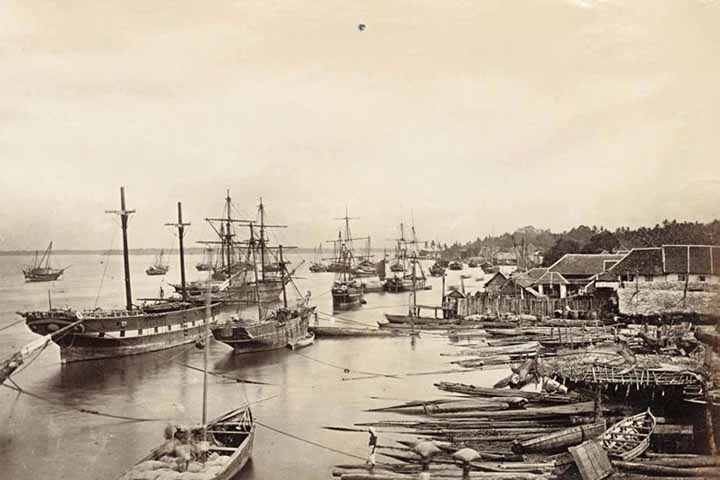
Kochi was the centre of Indian spice trade for many centuries, and was known to the Yavanas (Greeks and Romans) as well
as Jews, Syrians, Arabs, and Chinese since ancient times. It rose to significance as a trading centre after the port
Muziris around Kodungallur (Cranganore) was destroyed by massive flooding of Periyar in 1341. The earliest documented
references to Kochi occur in books written by Chinese voyager Ma Huan during his visit to Kochi in the 15th century as
part of Admiral Zheng He's treasure fleet. There are also references to Kochi in accounts written by Italian traveller
Niccolò Da Conti, who visited Kochi in 1440.
According to many historians, the precursor state to Kingdom of Kochi came into existence in the early 12th century,
after the fall of the Chera Kingdom. The reign of the Kingdom was hereditary, and the family that ruled over the
region was known as the Perumpadappu Swaroopam in the local vernacular.
Portuguese navigator, Pedro Álvares Cabral founded the first European settlement in India at Kochi in 1500. From 1503
to 1663, Fort Kochi (Fort Emmanuel) was ruled by Portugal. This Portuguese period was a harrowing time for the Saint
Thomas Christians and the Jews, as the Inquisition was active in Portuguese India. Kochi hosted the grave of Vasco da
Gama, the first European explorer to set sail for India, who was buried at St. Francis Church until his remains were
returned to Portugal in 1539. The Portuguese rule was followed by that of the Dutch who renamed Fort Immanuel as Fort
Stormsburg. In meantime, the Royal Family of Kochi relocated the capital of Kochi Kingdom to Thrissur, leaving nominal
authority over Islands of Kochi. In 1664, Fort Kochi Municipality was established by Dutch, making it the first
municipality in Indian subcontinent, which got dissolved when Dutch authority got weaker in the 18th century. The
remaining part of Kochi were governed by governors of Kochi Kingdom. By 1773, the Mysore ruler Hyder Ali extended his
conquest in the Malabar region to Kochi forcing it to become a tributary of Mysore. The hereditary Prime Ministership of
Kochi held by the Paliath Achans ended during this period.
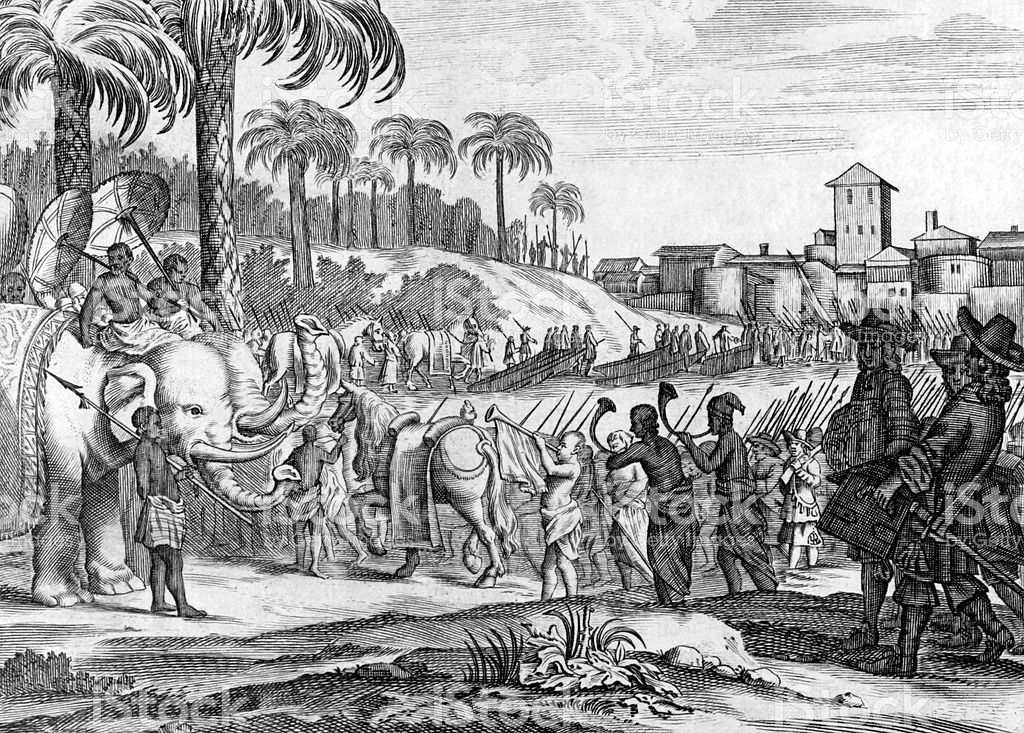 Meanwhile, the Dutch, fearing an outbreak of war on the United Provinces, signed the Anglo-Dutch Treaty of 1814 with the
United Kingdom, under which Kochi was ceded to the United Kingdom in exchange for the island of Bangka. However, there
are evidences of English habitation in the region even before the signing of the treaty. In 1866, Fort Kochi municipality
was reinstalled and its first Municipal Council seating contest was conducted in 1883. In 1896, H.H. Rama Varma XV,
The Maharaja of Cochin, initiated local administration by forming town councils in Mattancherry and Ernakulam. In 1907,
the Governor of the Madras Presidency, Sir Arthur Lawley and his brother, Beilby Lawley, 3rd Baron Wenlock, Governor of
Madras, 1891 to 1896, left for an official tour of Cochin and Travancore, which lasted from 25 January to 14 February.
On 26 January, they were met by His Highness the Rajah of Cochin who gave a State Dinner in their honour at Ernakulam.
By the 1870s, the capital of Kochi Kingdom was relocated again to Kochi Suburb of Tripunithura. In 1910, Ernakulam
became the administrative capital of Kochi Kingdom with establishment of Royal Secretariat and State Durbar. The Offices
of Diwan and High court were soon moved into Ernakulam.
Meanwhile, the Dutch, fearing an outbreak of war on the United Provinces, signed the Anglo-Dutch Treaty of 1814 with the
United Kingdom, under which Kochi was ceded to the United Kingdom in exchange for the island of Bangka. However, there
are evidences of English habitation in the region even before the signing of the treaty. In 1866, Fort Kochi municipality
was reinstalled and its first Municipal Council seating contest was conducted in 1883. In 1896, H.H. Rama Varma XV,
The Maharaja of Cochin, initiated local administration by forming town councils in Mattancherry and Ernakulam. In 1907,
the Governor of the Madras Presidency, Sir Arthur Lawley and his brother, Beilby Lawley, 3rd Baron Wenlock, Governor of
Madras, 1891 to 1896, left for an official tour of Cochin and Travancore, which lasted from 25 January to 14 February.
On 26 January, they were met by His Highness the Rajah of Cochin who gave a State Dinner in their honour at Ernakulam.
By the 1870s, the capital of Kochi Kingdom was relocated again to Kochi Suburb of Tripunithura. In 1910, Ernakulam
became the administrative capital of Kochi Kingdom with establishment of Royal Secretariat and State Durbar. The Offices
of Diwan and High court were soon moved into Ernakulam.
In 1947, when India gained independence from the British colonial rule, Cochin was the first princely state to join the
Indian Union willingly. In 1949, Travancore-Cochin state came into being with the merger of Cochin and Travancore.
The King of Travancore was the Rajpramukh of the Travancore-Cochin Union from 1949 to 1956. Travancore-Cochin, was in
turn merged with the Malabar district of the Madras State. Finally, the Government of India's States Reorganisation Act
(1956) inaugurated a new state—Kerala—incorporating Travancore-Cochin (excluding the four southern Taluks which were
merged with Tamil Nadu), Malabar District, and the taluk of Kasargod, South Kanara. On 9 July 1960 the Mattancherry
council passed a resolution—which was forwarded to the government—requesting the formation of a municipal corporation
by combining the existing municipalities of Fort Kochi, Mattancherry, and Ernakulam. The government appointed a
commission to study the feasibility of the suggested merger. Based on its report, the Kerala Legislative Assembly
approved the corporation's formation. On 1 November 1967, exactly eleven years since the establishment of the state of
Kerala, the Kochi Municipal Corporation came into existence. The merger leading to the establishment of the corporation,
was between the municipalities of Ernakulam, Mattancherry and Fort Kochi, along with that of the Willingdon Island, four
panchayats , and the small islands of Gundu and Ramanthuruth. Kochi and Ernakulam district formed on 1 April 1958
carving areas of erstwhile Travancore-Kochi-Malabar kingdoms. Major portion of the district is from the Kochi kingdom.
Geography and Climate
Geography
Kochi is located on the southwest coast of India at 9°58'N 76°13'E, with a corporation limit area of 94.88 km2
(36.63 sq mi). Over the years, the city has expanded considerably outside the corporation limit set in 1967, although
the official city limits hasn't yet been increased.The city straddles the backwaters, encompassing the northern end of
a peninsula, several islands and a portion of the mainland. To the west lies the Laccadive Sea, and to the east is the
urbanised region in the rest of the mainland area. Much of Kochi lies at sea level, with a coastline of 48 km.
he current metropolitan limits of Kochi include the mainland Ernakulam, Fort Kochi, the suburbs of Edapally, Kalamassery
and Kakkanad to the northeast; Tripunithura to the southeast; and a group of islands closely scattered in the Vembanad
Lake. The state government and the GCDA have plans to include Mala and Kodungallur in Thrissur district, Angamaly,
Perumbavoor, Piravom and Kolenchery in Ernakulam district, Thalayolaparambu and Vaikom in Kottayam and Cherthala in
Alappuzha district within Kochi metropolitan limits. The newly formed metropolis would be put under the charge of a new
authority called Kochi Metropolitan Regional Development Authority.However, The Hindu reported that the state
government is yet to take any concrete steps in this regard.

Soil consists of sediments such as alluvium, teris, brown sands, etc. Hydromorphic saline soils are also found in the
areas surrounding the backwaters.
Predominant rock types found here are Archaean-basic dykes, Charnockites and Gneisses. An ecologically sensitive area,
the Mangalavanam Bird Sanctuary is located in the central part of the city. It has a wide range of mangrove species and
is a nesting ground for a vast variety of migratory birds.
Kochi's water needs are entirely dependent on ground water and the two rivers flowing through the district viz., Periyar
and Muvattupuzha. Periyar serves the entire northern part of the city whereas Muvattupuzha river under the JnNurm
project covers the western part.
Climate
Under the Köppen climate classification, Kochi features a tropical monsoon climate (Am). Kochi's proximity to the equator
along with its coastal location results in little seasonal temperature variation, with moderate to high levels of
humidity. Annual temperatures range between 23 and 31 °C (73 and 88 °F) with the record high being 36.5 °C (97.7 °F),
and record low 16.3 °C (61.3 °F).From June to September, the south-west monsoon brings in heavy rains as Kochi lies on
the windward side of the Western Ghats. From October to December, Kochi receives lighter (yet significant) rain from the
northeast monsoon, as it lies on the leeward side. Average annual rainfall is 2,978.0 mm (117.24 in), with an annual
average of 125 rainy days.
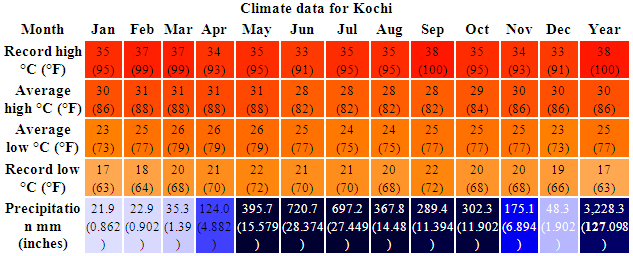
Transport
By Air
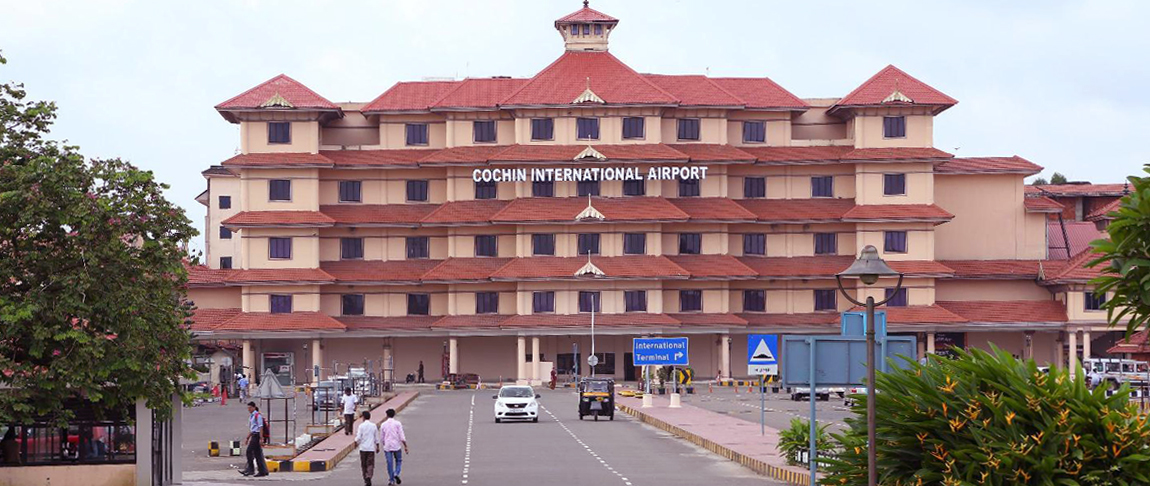
The air gateway to Kochi is the Cochin International Airport (CIAL) located at Nedumbassery, which is about 28 km (17 mi)
north of Kochi city, and handles both domestic and international flights.It is the first international airport in India
to be built without Central Government funds and is the world's first fully solar energy powered airport.
The Cochin airport provides direct connectivity to popular international destinations in the Middle East, Malaysia, Thailand and
Singapore and to most major Indian cities apart from tourist destinations like Lakshadweep. Kochi is also the
headquarters of the Air India Express service. With a terminal area of 840,000 sq ft (78,000 m2), and a passenger
capacity of 2200 (international and domestic), it is the largest and busiest airport in the state.It is also the fourth
busiest airport in India in terms of international passenger traffic, and seventh busiest overall.
By Road

Kochi is well connected to neighbouring cities and states via several highways. It is a node in the North-South Corridor
of the National Highway system.The road infrastructure in Kochi has not been able to meet the growing traffic demand and
hence traffic congestion is a major problem in the city.
Kochi is served by National Highway 66, National Highway 544, National Highway 966A and National Highway 966B.
Several state highways also connect Kochi with other parts of Kerala.SH 15, Ettumanoor-Ernakulam Road, connects the city
to Kottayam, Pala, Kumily, Changanacherry, Pathanamthitta etc. SH 41, Palarivattom-Thekkady Road, provides a corridor to
the eastern parts of the district. SH 63, Vypeen Pallipuram Road and SH 66, Alappuzha – Thoppumpady road are coastal
roads that serve the narrow sliver of land between the backwaters and the sea.
The main arterial roads of the city are the Mahatma Gandhi Road and Sahodaran Ayyappan Road in Ernakulam, constructed in
1925 & 1962 respectively which runs parallel & perpendicular to the coast and having the proposed Metro Rail
connectivity. The Seaport-Airport Road is another major road and connects the Cochin Seaport to the Cochin International
Airport. The Infopark Expressway in Kakkanad is connected to the Seaport-Airport Road and stretches all the way to
Infopark. Other major roads include Chittoor Road, Banerji Road, Shanmugham Road, Kochi Bypass, Kaloor-Kadavanthra Road,
Park Avenue etc. A new ring road is proposed for Kochi city by the state government for which a project study is being
currently undertaken by NATPAC.
By Rail
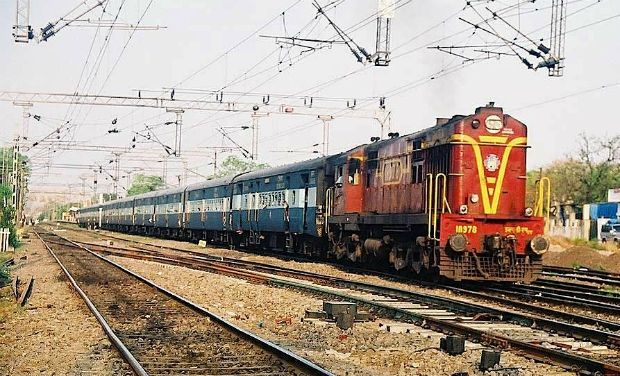
The city has four major railway stations – Ernakulam Junction, Ernakulam Town , Aluva and Tripunithura followed by
smaller stations, Edapally and Kalamassery. There is also the Cochin Harbour Terminus providing rail connectivity to the
southern segment of the Port of Kochi. The terminus is currently under renovation for the suburban rail networks in the
city. The main rail transport system in Kochi is operated by the Southern Railway Zone of Indian Railways, and comes
under Thiruvananthapuram Railway division. The South station is one of the busiest railway stations in South India, with
more than 128 scheduled train services daily.The North station situated on the northern side of the city, caters
mostly to long distance services that bypass the South station, and also is an additional halt station for many trains.
There is also a historic station named as Ernakulam Terminus situated behind the High Court. Great personalities like
Mahatma Gandhi and The British Viceroy have visited Cochin through this old railway station. Ernakulam Terminus was the
first station to serve the city but had to be abandoned in the early 1960s. Now this station operates as a goods depot of
Southern Railway.
Metro

The Kochi Metro is a metro rapid transit system serving the city of Kochi, intended to considerably ease traffic
congestion in the city and its surrounding metropolitan area.It is being set up at an overall estimated cost of
?5,146 crore (US$770 million). The Phase-1 of the metro system will have 22 stations connecting the suburban towns of
Aluva and Pettah while passing through downtown.The first half of the Phase-1 of Kochi Metro was inaugurated on 17 June
2017 by Indian Prime Minister Narendra Modi. Currently Kochi Metro is operational from Aluva till Maharaja's College
along the Kalamassery - Edappally - Kaloor - MG Road stretch, covering a total of 18.4 km with 16 operational metro
stations.
Tourists Places in Kochi
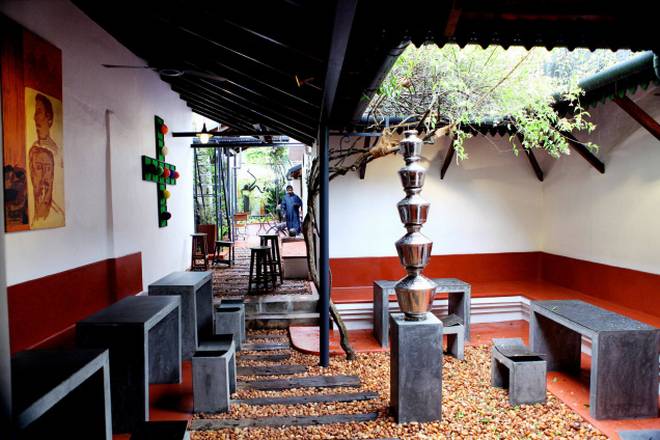
Kashi Art Cafe
An art gallery and a cafe, this place is one of a kind - wherein you can admire art and also have a bite to eat. They
serve excellent chocolate cakes, breakfast and lunch, coupled with nice music and a soothing ambience.
The cafe was started in 1997 in Fort Kochi by two art lovers Anoop Skaria and Dorrie Younger. In 2003, they expanded and
got another space with the same objective in Mattancherry. The idea behind this is sure to touch the souls of all
artists and art lovers. Kashi Art cafe provides a platform for all talented artists who have no support structure to
bring their talent out in the spotlight. Established artists also display their work here. The profits from the cafe
totally support art and cultural activities. This gallery has today become a milestone in the contemporary art scene
in India.

Shiva Temple
In front of the Shiva temple in Ernakulam lies the backwaters of Cochin. The deity faces westwards and enjoys the view
of the sea. At the time of constructing this temple, the main language that was in use was Tamil; therefore the people
addressed the deity as Erayanar which also means Lord Shiva.
There are two legendary stories connected to this temple. The first is thus: A sage was observing strict penance on the
Himalayas. He had a disciple called Devalan. Because of his bad behaviour, he was cursed to become a serpent. To be
freed from the curse, he had to fetch a Shiva Linga kept by another serpent in the Behula forest. He drew up a plan and
got the Linga. When he was returning from there, he stopped on the way to have a bath. After bath and offering prayers,
he couldn t remove the Shiva Linga, it was firmly fixed to the ground. The Shiva temple which is there now is believed
to have cropped up at that time. The place was called Hrishingakulam (Hrishinga was the changed name of Devalan). It has
now been shortened to Ernakulam.
The second is: Arjuna was performing penance to impress Shiva. To test him, Shiva disguised himself as a Kiratha a demon
and just before Shiva appeared before Arjuna, he saw a boar running towards him. Arjuna, an ace hunter shot the boar. A
dispute arose between Kiratha and Arjuna as to who shot the boar. After a long battle Kiratha emerged as the winner and
then Arjuna realised that it is actually Shiva in disguise. Shiva and Parvathy together appeared and gifted Arjuna the
Pashupathastram. The idol of Shiva is said to have emerged on its own.
The Shiva temple celebrates Mahashivarathri with great pomp and show. Remember that while entering the temple, men are
supposed to take off their shirts.
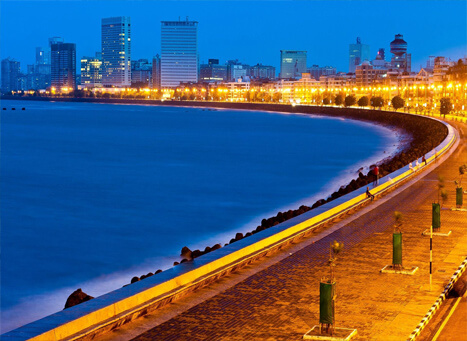
Marine Drive
Marine Drive is a 1.75 km long beautiful promenade, which has been built facing the backwaters of Kochi. One of the most
popular hangout areas for the locals as well as tourists in the city, Marine Drive is a walkway. Featuring numerous
shopping malls and fast food joints, this place is an important hub of economic activities in Kochi. Tourists visit this
place during evenings, to catch a glimpse of rising sun over the sea mouth.
The Marine Drive walkway begins from the High Court Junction and stretches until the Rajendra Maidan. Towards the
northern part of this walkway is a Public Ground, which is the venue for hosting major exhibitions. This park is also
the important political meetings point in the city. The important landmark of Marine Drive is the Marine Walkway, which
stretches from Subhash Chandra Bose Park in the south, to KSINC Boat Jetty in the north. The Rainbow Bridge, the China
Net Bridge and GCDA Shopping Complex are other major highlights of this walkway.
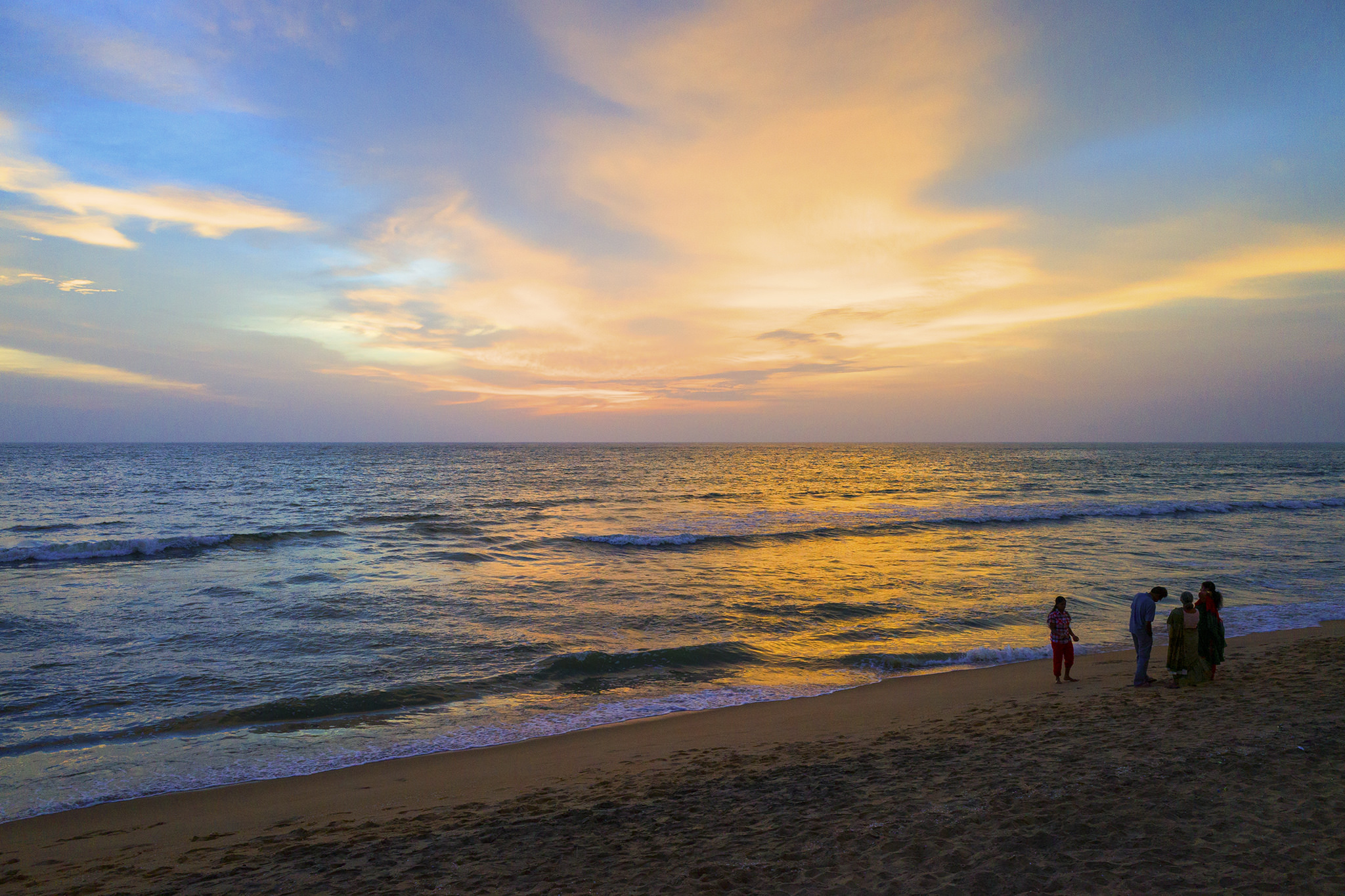
Cherai Beach
The panoramic Cherai beach is at the end of Vypeen Island, one of the many tiny islands off the shoreline. This panoramic
island can be easily reached by boat and land. This isolated yet enchanting beach is far away from commercial activities,
cocooned by palm and coconut trees, azure waters and golden sand. There are a variety of water sports and beach
activities to enjoy.

Chottanikkara Temple
Chottanikkara temple is dedicated to the Goddess Bhagawati, one of the most popular deities of Kerala. Besides, this
temple is also enshrined with the deity of Lord Vishnu. The principal deity in this temple is Goddess Rajeshwari, which
is worshipped in three different forms. Devotees worship the deity as goddess Saraswati in the morning, goddess
Badrakali in the afternoon, while goddess Durga in the evening.
Interestingly, the idol of the goddess mounted on sand instead of being fixed on the ground. The main festival of Maasi
Makam is celebrated in this temple during the month of Kumbha, from February through March.
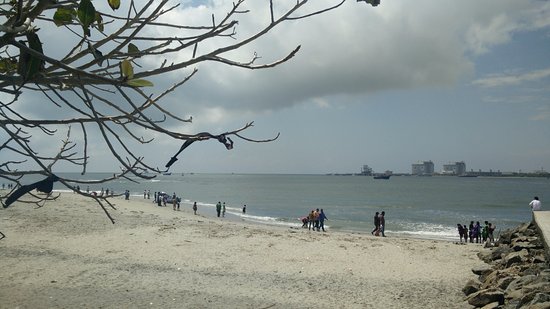
Fort Kochi Beach
Fort Kochi Beach is situated around 12 km away from the Kochi city. This beach is regarded as one of the most beautiful
beaches in Kerala. Cochin Carnival, which is celebrated at the time a week before New Year is the highlight of the
beach.
Fort Kochi is a small village close to the suburbs of the main city. With panoramic beaches all along the coastline, you
can see the famed Chinese fishing nets and sailing ships. The beautiful village and countryside is lined with old
Victorian era styled bungalows, a reminiscent of the European settlements. This location was the first settlement of the
Europeans in Kochi.
Besides the fort, this beach is also famous for water sports like scuba diving, wind surfing, parasailing and snorkelling.
Fort Kochi Beach is also ideal for water sports like catamaran sailing, kayaking and canoeing.

St. George Ferona Church
St. George Ferona Church is a Roman Catholic Church, which was built in the 594 AD. Counted among the oldest churches of
Kerala, this church is constructed on a land donated by the Raja of Edappally. Originally, this church was built in the
name of Virgin Mary. This church was rechristened as the St.George's Church, when St. George was officially recognised
as the Patron Saint of England.
This church features a statue of St. George, which shows the Saint on horseback with his spear piercing the ugly head of
serpent lying under the hooves of his horse. According to the Italian legend, it is believed that the Saint was rescuing
a noble damsel, who was offered to the monster as his food. The deity of this church is said to have the power of getting
rid of snakes.
Every year during the month of April and May, a grand nine-day festival is celebrated in this church. This festival
begins on the 23rd of April every year and lasts till 4th May, when the idol is taken out in a grand procession, with the
pilgrims throwing puri and beetle leaves as offering. Located 10 km away from Kochi in Edapally, this church is well
connected to the city by road and rail.
Culture
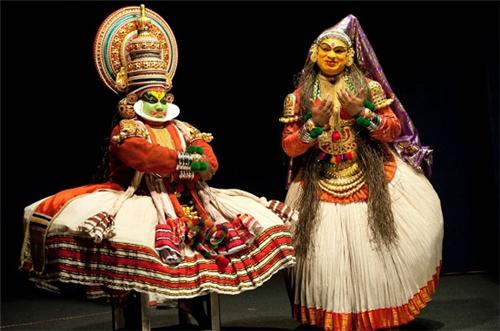
As a result of successive waves of migration over the course of several centuries, the population of the city is a mix of
people from all parts of Kerala and most of India. The pan-Indian nature is highlighted by the substantial presence of
various ethnic communities from different parts of the country.
Kochi has a diverse, multicultural, and secular community consisting of Malayalis, Konkanis,Gujaratis,Bengalis,Marathis,
Punjabis,Tamilians, Kannadigas, Biharias, Anglo Indians and a few families of Jews among other denominations, all living
in peaceful co-existence. The city once had a large Jewish community, known as the Malabar Yehuden—and now increasingly
as Cochin Jews— who figured prominently in Kochi's business and economic strata and owned several Synagogues across
Kochi and nearby areas such as Chendamangalam, Paravur or Mala.
Kochi was one among the seven diocese of Syrian Orthodox (Jacobite Syrian Christian Church) in Kerala formed in 1876. The
seat of the Bishop is at St George Cathedral, Karingachira. Also At Mary's Cathedral Elamkulam, seat of bishop of
Simhasana churches of Jacobites is in the City. The seat of Roman Catholic Cathedral of Kerala's first Archdiocese
Archdiocese of Verapoly and the first diocese Diocese of Cochin are located in the city. The Syro-Malabar Church, one of
the 22 sui iuris Eastern Catholic Churches and a part of the Saint Thomas Christian community, has its seat at Ernakulam.
Prominent places of Christian worship include the St. Mary's Syro-Malabar Catholic Cathedral Basilica, Ernakulam,
St. Francis Assisi Roman Catholic Cathedral, Ernakulam, Basilica of Our Lady of Ransom, Vallarpadam-Ernakulam, Santa Cruz
Basilica Roman Catholic Cathedral, Fort Kochi, St. Antony's Shrine at Kaloor, St. George Forane Church, Edappally and .
Appropriate to its multi-ethnic composition, Kochi celebrates traditional Kerala festivals like Onam and Vishu along
with North Indian Hindu festivals like Holi with great fervour. Christian and Islamic festivals like Christmas, Easter,
Eid ul-Fitr and Milad-e-sherif are also celebrated. A merry making fest called the Cochin Carnival is celebrated at Fort
Kochi during the last ten days of December.

 Meanwhile, the Dutch, fearing an outbreak of war on the United Provinces, signed the Anglo-Dutch Treaty of 1814 with the
United Kingdom, under which Kochi was ceded to the United Kingdom in exchange for the island of Bangka. However, there
are evidences of English habitation in the region even before the signing of the treaty. In 1866, Fort Kochi municipality
was reinstalled and its first Municipal Council seating contest was conducted in 1883. In 1896, H.H. Rama Varma XV,
The Maharaja of Cochin, initiated local administration by forming town councils in Mattancherry and Ernakulam. In 1907,
the Governor of the Madras Presidency, Sir Arthur Lawley and his brother, Beilby Lawley, 3rd Baron Wenlock, Governor of
Madras, 1891 to 1896, left for an official tour of Cochin and Travancore, which lasted from 25 January to 14 February.
On 26 January, they were met by His Highness the Rajah of Cochin who gave a State Dinner in their honour at Ernakulam.
By the 1870s, the capital of Kochi Kingdom was relocated again to Kochi Suburb of Tripunithura. In 1910, Ernakulam
became the administrative capital of Kochi Kingdom with establishment of Royal Secretariat and State Durbar. The Offices
of Diwan and High court were soon moved into Ernakulam.
Meanwhile, the Dutch, fearing an outbreak of war on the United Provinces, signed the Anglo-Dutch Treaty of 1814 with the
United Kingdom, under which Kochi was ceded to the United Kingdom in exchange for the island of Bangka. However, there
are evidences of English habitation in the region even before the signing of the treaty. In 1866, Fort Kochi municipality
was reinstalled and its first Municipal Council seating contest was conducted in 1883. In 1896, H.H. Rama Varma XV,
The Maharaja of Cochin, initiated local administration by forming town councils in Mattancherry and Ernakulam. In 1907,
the Governor of the Madras Presidency, Sir Arthur Lawley and his brother, Beilby Lawley, 3rd Baron Wenlock, Governor of
Madras, 1891 to 1896, left for an official tour of Cochin and Travancore, which lasted from 25 January to 14 February.
On 26 January, they were met by His Highness the Rajah of Cochin who gave a State Dinner in their honour at Ernakulam.
By the 1870s, the capital of Kochi Kingdom was relocated again to Kochi Suburb of Tripunithura. In 1910, Ernakulam
became the administrative capital of Kochi Kingdom with establishment of Royal Secretariat and State Durbar. The Offices
of Diwan and High court were soon moved into Ernakulam.













